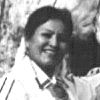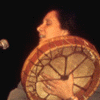13 November 1995
EOL record review
Heartbeat:
Voices of First Nations Women

linked fullsize image
record cover
94 kB .gif
Smithsonian/Folkways CD/cassette. 1995. SF 40415. 69:43.
"Heartbeat" attempts an overview of music by Native American women. It includes traditional women's songs, material usually sung by men and recently taken up by women, and contemporary compositions which merge traditional styles with various non- Native musics. The compilation highlights the great variety of traditional music performed by Native women, an important yet little known aspect of Native American music, and women's creativity in today's musical world.
Several of the performers sing traditional women's music, some of which has been passed through the generations, such as gambling songs from the Northwest Coast, Creek story-telling songs, and Athabaskan traditional honoring songs. Other songs from the women's repertoire are of more recent origin, such as a Kiowa honoring song, and an Olla Maidens' Blessing song (Zuñi Pueblo).
The Sweethearts of Navajoland sing two skip dance songs, the
traditional accompaniment for a social couple dance which is also part of the
Enemy Way ceremonial. They have been singing since 1989 at ceremonials
and festivals, and now also make their own songs. "One woman's man"
is a good example of the contemporary nature
of these songs, as people compose new ones on inspiration, sometimes
including English words in the Navajo lyrics.
Their vocal style is typical of Navajo singing, as is the accompaniment, a water drum played with a
cedarwood beater.

linked fullsize image
Sweethearts of Navajoland
94 kB .GIF
[PC audio, 185 kB .wav]
[Mac audio, 185 kB .aif]
Women who have taken up traditional men's singing include the Six Nations Women Singers' new women's shuffle dance songs (Iroquois), a genre traditionally sung by men to accompany women's dancing. Also featured are the Crying Woman Singers (Cree), a women's pow-wow group who drum as they sing, performing the men's musical role, and Nancy Richardson (Karuk) who sings in the male vocal style, characterized by a complex, ornamented melody, and a sobbing vocal quality.
Georgia Wettlin-Larsen (Assiniboine-Nakota) gives a striking
performance of a Lakota flute song
in which she uses her voice to imitate the stops, trills and leaps of the
traditionally male Plains courting flute.

linked fullsize image
Wettlin-Larsen
49 kB .GIF
[PC audio, 249 kB .wav]
[Mac audio, 249 kB .aif]
A variety of performances by women
represent a range of contemporary trends. The Tewa Indian women's choir
sings "Holy, holy holy," part of one of the masses composed in the Tewa language. It blends the musical
styles of the Tewa Pueblo, Spanish folk mass, and Catholic plainsong. Bells, a drum, a rattle and a church organ accompany the voices.
[PC audio, 179 kB .wav]
[Mac audio, 179 kB .aif]
In the folk vein, we hear Joanne Shenandoah, Geraldine Barney, Buffy
Sainte-Marie, and Ulali, a group consisting of women from various
backgrounds (Cherokee/Tuscarora, Aztec/Maya), all of whom combine
traditional and contemporary elements in their compositions. Ulali's song
"Going home" combines musical styles of Plains and
Woodlands phrasings; drums, rattles and rhythms from the Southeastern
Stompdance; Mexican Indian musical form; and vocal riffs from African-
American musical traditions. One of the singers, Pura F�, says of their
interpretation of the historical connection between Southeastern Native and
African musical traditions, " Many people were among us. We weren't
just one kind, We sang and worked together. And that's the birth of the
blues."

linked fullsize image
Ulali group
85 kB .GIF
medium-quality audio, 7 sec., 60 kB .AU (default)
higher-quality, longer audio, 15 sec., 352 kB .AIF
"Heartbeat: Voices of First Nations Women" provides a good introduction to Native American music for the novice, and new material to people already familiar with some of the traditions. Its main accomplishment is to bring to the forefront the songs and music of women one rarely gets a chance to listen to and appreciate.
Johanna Hofmann
University of California, Los Angeles
Return to EF/hm home page
Comments to author, editor, or ERD public discussion